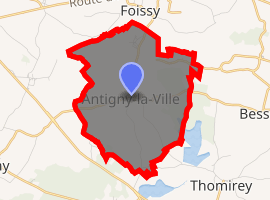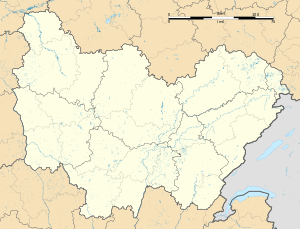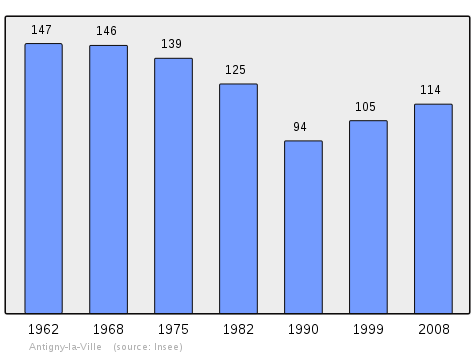Antigny-la-Ville
Antigny-la-Ville is a French commune in the Côte-d'Or department in the Bourgogne-Franche-Comté region of eastern France.
Antigny-la-Ville | |
|---|---|
The road into Antigny-la-Ville | |
Location of Antigny-la-Ville 
| |
 Antigny-la-Ville  Antigny-la-Ville | |
| Coordinates: 47°06′08″N 4°33′34″E | |
| Country | France |
| Region | Bourgogne-Franche-Comté |
| Department | Côte-d'Or |
| Arrondissement | Beaune |
| Canton | Arnay-le-Duc |
| Intercommunality | Pays d'Arnay |
| Government | |
| • Mayor (2008–2020) | Roger Gagnepain |
| Area 1 | 8.4 km2 (3.2 sq mi) |
| Population (2017-01-01)[1] | 102 |
| • Density | 12/km2 (31/sq mi) |
| Time zone | UTC+01:00 (CET) |
| • Summer (DST) | UTC+02:00 (CEST) |
| INSEE/Postal code | 21015 /21230 |
| Elevation | 406–457 m (1,332–1,499 ft) |
| 1 French Land Register data, which excludes lakes, ponds, glaciers > 1 km2 (0.386 sq mi or 247 acres) and river estuaries. | |
The inhabitants of the commune are known as Antinniens or Antinniennes[2]
Geography
Antigny-la-Ville is located some 60 km south-west of Dijon and 25 km north-west of Beaune. It can be accessed by the minor road D111 which runs off the D33 west of Bligny-sur-Ouche and passes west through the commune and the village continuing to join the D906 in the west. The D14 road also comes from Culètre in the north also passing through the village and continuing south to Lacanche. There are also many local roads giving access to the commune. In addition to the village there is also the hamlet of Chamoy in the north. The commune is mostly farmland but there are large forests in the west (the Bois du Petit Rondeau and the Bois de Retraite).[3]
The Ruisseau du Breuil forms part of the northern border of the commune and gathers some tributaries which rise in the commune flowing west through the Étang de Breuil to join the Arroux south of Viscolon.[3]
Neighbouring communes and villages[3]
History
During the revolutionary period of the National Convention (1792-1795), the commune was called Antigny-la-Montagne.[4]
Administration
List of Successive Mayors[5]
| From | To | Name | Party | Position |
|---|---|---|---|---|
| 2001 | 2008 | Robert Marquet | ||
| 2001 | 2020 | Roger Gagnepain |
(Not all data is known)
Demography
In 2009 the commune had 112 inhabitants. The evolution of the number of inhabitants is known from the population censuses conducted in the commune since 1793. From the 21st century, a census of communes with fewer than 10,000 inhabitants is held every five years, unlike larger towns that have a sample survey every year.[Note 1]
| 1793 | 1800 | 1806 | 1821 | 1831 | 1836 | 1841 | 1846 | 1851 |
|---|---|---|---|---|---|---|---|---|
| 240 | 239 | 332 | 306 | 265 | 318 | 314 | 323 | 314 |
| 1856 | 1861 | 1866 | 1872 | 1876 | 1881 | 1886 | 1891 | 1896 |
|---|---|---|---|---|---|---|---|---|
| 327 | 283 | 268 | 281 | 263 | 230 | 232 | 213 | 196 |
| 1901 | 1906 | 1911 | 1921 | 1926 | 1931 | 1936 | 1946 | 1954 |
|---|---|---|---|---|---|---|---|---|
| 181 | 183 | 198 | 179 | 176 | 164 | 152 | 147 | 134 |
| 1962 | 1968 | 1975 | 1982 | 1990 | 1999 | 2006 | 2009 | - |
|---|---|---|---|---|---|---|---|---|
| 147 | 146 | 139 | 125 | 94 | 105 | - | 112 | - |

Culture and heritage
Religious heritage
The Pariish Church of the Assumption contains several items that are registered as historical objects:
- A Bronze Bell (1734)

- A Painting: The vow of Louis XIII (17th century)

- A Statue: Saint Benoit (16th century)

- The Furniture in the Church

- 5 Stained glass windows (Bays 5, 6, 7, and 80) (1875)

- 5 Stained glass figures (Bays 1, 2, 3, 4, and 9) (1875)

Notable people linked to the commune
- Florette Antigny appears in an obituary in the Abbey of Saint-Martin of Autun: VII id Floreta Antigny (13th century).[12]
See also
External links
Notes and references
Notes
- At the beginning of the 21st century, the methods of identification have been modified by Law No. 2002-276 of 27 February 2002, the so-called "law of local democracy" and in particular Title V "census operations" allows, after a transitional period running from 2004 to 2008, the annual publication of the legal population of the different French administrative districts. For communes with a population greater than 10,000 inhabitants, a sample survey is conducted annually, the entire territory of these communes is taken into account at the end of the period of five years. The first "legal population" after 1999 under this new law came into force on 1 January 2009 and was based on the census of 2006.
References
- "Populations légales 2017". INSEE. Retrieved 6 January 2020.
- Inhabitants of Côte-d'Or (in French)
- Google Maps
- Cassini-Ehess, Communal Notice - Antigny-la-Ville, consulted on 31 July 2012 (in French)
- List of Mayors of France
- Ministry of Culture, Palissy PM21000035 Bronze bell (in French)
- Ministry of Culture, Palissy PM21000034 Painting: The vow of Louis XIII

- Ministry of Culture, Palissy PM21000033 Statue: Saint Benoit
- Ministry of Culture, Palissy IM21001613 Furniture in the Church
- Ministry of Culture, Palissy IM21000976 5 Stained glass windows (Bays 5, 6, 7, and 80)
- Ministry of Culture, Palissy IM21000975 5 Stained glass figures (Bays 1, 2, 3, 4, and 9)
- Jacques-Gabriel Bulliot, Historical Essay on the Abbey of Saint-Martin d'Autun, extract from the obituary, p. 382. (in French)
| Wikimedia Commons has media related to Antigny-la-Ville. |